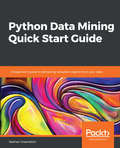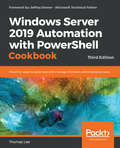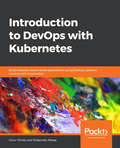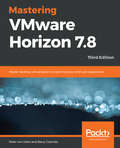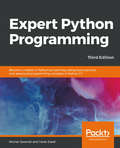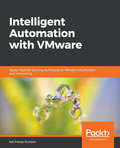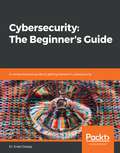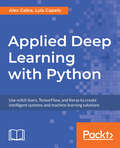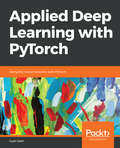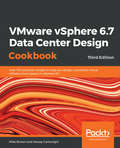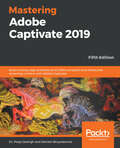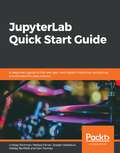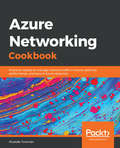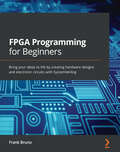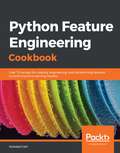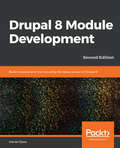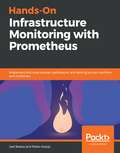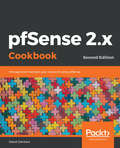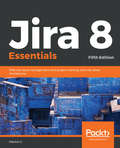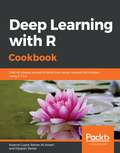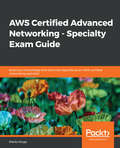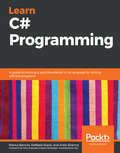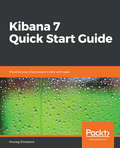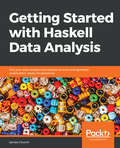- Table View
- List View
Python Data Mining Quick Start Guide: A beginner's guide to extracting valuable insights from your data
by Nathan GreeneltchExplore the different data mining techniques using the libraries and packages offered by PythonKey FeaturesGrasp the basics of data loading, cleaning, analysis, and visualizationUse the popular Python libraries such as NumPy, pandas, matplotlib, and scikit-learn for data miningYour one-stop guide to build efficient data mining pipelines without going into too much theoryBook DescriptionData mining is a necessary and predictable response to the dawn of the information age. It is typically defined as the pattern and/ or trend discovery phase in the data mining pipeline, and Python is a popular tool for performing these tasks as it offers a wide variety of tools for data mining.This book will serve as a quick introduction to the concept of data mining and putting it to practical use with the help of popular Python packages and libraries. You will get a hands-on demonstration of working with different real-world datasets and extracting useful insights from them using popular Python libraries such as NumPy, pandas, scikit-learn, and matplotlib. You will then learn the different stages of data mining such as data loading, cleaning, analysis, and visualization. You will also get a full conceptual description of popular data transformation, clustering, and classification techniques.By the end of this book, you will be able to build an efficient data mining pipeline using Python without any hassle.What you will learnExplore the methods for summarizing datasets and visualizing/plotting dataCollect and format data for analytical workAssign data points into groups and visualize clustering patternsLearn how to predict continuous and categorical outputs for dataClean, filter noise from, and reduce the dimensions of dataSerialize a data processing model using scikit-learn’s pipeline featureDeploy the data processing model using Python’s pickle moduleWho this book is forPython developers interested in getting started with data mining will love this book. Budding data scientists and data analysts looking to quickly get to grips with practical data mining with Python will also find this book to be useful. Knowledge of Python programming is all you need to get started.
Windows Server 2019 Automation with PowerShell Cookbook - Third Edition
by Thomas LeeIf you are a systems administrator, engineer, or an architect working with Windows Server 2016 interested in upgrading to Windows Server 2019 and automating tasks with PowerShell, then this book is for you. A basic knowledge of PowerShell is expected.
Introduction to DevOps with Kubernetes: Build scalable cloud-native applications using DevOps patterns created with Kubernetes
by Onur Yılmaz Süleyman AkbaşBecome familiar with Kubernetes and explore techniques to manage your containerized workloads and services Key FeaturesLearn everything from creating a cluster to monitoring applications in KubernetesUnderstand and develop DevOps primitives using KubernetesUse Kubernetes to solve challenging real-life DevOps problemsBook DescriptionKubernetes and DevOps are the two pillars that can keep your business at the top by ensuring high performance of your IT infrastructure. Introduction to DevOps with Kubernetes will help you develop the skills you need to improve your DevOps with the power of Kubernetes. The book begins with an overview of Kubernetes primitives and DevOps concepts. You'll understand how Kubernetes can assist you with overcoming a wide range of real-world operation challenges. You will get to grips with creating and upgrading a cluster, and then learn how to deploy, update, and scale an application on Kubernetes. As you advance through the chapters, you’ll be able to monitor an application by setting up a pod failure alert on Prometheus. The book will also guide you in configuring Alertmanager to send alerts to the Slack channel and trace down a problem on the application using kubectl commands. By the end of this book, you’ll be able to manage the lifecycle of simple to complex applications on Kubernetes with confidence.What you will learnCreate and manage Kubernetes clusters in on-premise systems and cloudExercise various DevOps practices using KubernetesExplore configuration, secret, and storage management, and exercise these on KubernetesPerform different update techniques and apply them on KubernetesUse the built-in scaling feature in Kubernetes to scale your applications up and downUse various troubleshooting techniques and have a monitoring system installed on KubernetesWho this book is forIf you are a developer who wants to learn how to apply DevOps patterns using Kubernetes, then this book is for you. Familiarity with Kubernetes will be useful, but not essential.
Mastering VMware Horizon 7.5 - Third Edition: Master desktop virtualization to optimize your end user experience, 3rd Edition
by Peter von OvenThis book is ideal for system admins, and solution architects interested in gaining hands-on experience with virtualization. It will take you to an advanced level, but at a pace that ensures you re always solving real-world problems. Some experience in desktop management using Windows and Microsoft Office, and familiarity with Active Directory, SQL, Windows Remote Desktop Session Hosting, and VMware vSphere technology is necessary.
Expert Python Programming,: Become a master in Python by learning coding best practices and advanced programming concepts in Python 3.7, 3rd Edition
by Michał Jaworski Tarek ZiadéRefine your Python programming skills and build professional grade applications with this comprehensive guideKey FeaturesCreate manageable code that can run in various environments with different sets of dependenciesImplement effective Python data structures and algorithms to write optimized codeDiscover the exciting new features of Python 3.7Book DescriptionPython is a dynamic programming language that's used in a wide range of domains thanks to its simple yet powerful nature. Although writing Python code is easy, making it readable, reusable, and easy to maintain is challenging. Complete with best practices, useful tools, and standards implemented by professional Python developers, the third edition of Expert Python Programming will help you overcome this challenge.The book will start by taking you through the new features in Python 3.7. You'll then learn the advanced components of Python syntax, in addition to understanding how to apply concepts of various programming paradigms, including object-oriented programming, functional programming, and event-driven programming. This book will also guide you through learning the best naming practices, writing your own distributable Python packages, and getting up to speed with automated ways of deploying your software on remote servers. You’ll discover how to create useful Python extensions with C, C++, Cython, and CFFI. Furthermore, studying about code management tools, writing clear documentation, and exploring test-driven development will help you write clean code.By the end of the book, you will have become an expert in writing efficient and maintainable Python code.What you will learnExplore modern ways of setting up repeatable and consistent development environmentsPackage Python code effectively for community and production useLearn modern syntax elements of Python programming such as f-strings, enums, and lambda functionsDemystify metaprogramming in Python with metaclassesWrite concurrent code in PythonExtend Python with code written in different languagesIntegrate Python with code written in different languagesWho this book is forThis book will appeal to you if you’re a programmer looking to take your Python knowledge to the next level by writing efficient code and learning the latest features of version 3.7 and above.
Intelligent Automation with VMware: Apply machine learning techniques to VMware virtualization and networking
by Ajit Pratap KundanUse self-driven data centers to reduce management complexity by deploying Infrastructure as Code to gain value from investments. Key Features Add smart capabilities in VMware Workspace ONE to deliver customer insights and improve overall security Optimize your HPC and big data infrastructure with the help of machine learning Automate your VMware data center operations with machine learning Book Description This book presents an introductory perspective on how machine learning plays an important role in a VMware environment. It offers a basic understanding of how to leverage machine learning primitives, along with a deeper look into integration with the VMware tools used for automation today. This book begins by highlighting how VMware addresses business issues related to its workforce, customers, and partners with emerging technologies such as machine learning to create new, intelligence-driven, end user experiences. You will learn how to apply machine learning techniques incorporated in VMware solutions for data center operations. You will go through management toolsets with a focus on machine learning techniques. At the end of the book, you will learn how the new vSphere Scale-Out edition can be used to ensure that HPC, big data performance, and other requirements can be met (either through development or by fine-tuning guidelines) with mainstream products. What you will learn Orchestrate on-demand deployments based on defined policies Automate away common problems and make life easier by reducing errors Deliver services to end users rather than to virtual machines Reduce rework in a multi-layered scalable manner in any cloud Explore the centralized life cycle management of hybrid clouds Use common code so you can run it across any cloud Who this book is for This book is intended for those planning, designing, and implementing the virtualization/cloud components of the Software-Defined Data Center foundational infrastructure. It helps users to put intelligence in their automation tasks to get self driving data center. It is assumed that the reader has knowledge of, and some familiarity with, virtualization concepts and related topics, including storage, security, and networking.
Cybersecurity: A comprehensive guide to getting started in cybersecurity
by Dr. Erdal OzkayaUnderstand the nitty-gritty of Cybersecurity with easeKey FeaturesAlign your security knowledge with industry leading concepts and toolsAcquire required skills and certifications to survive the ever changing market needsLearn from industry experts to analyse, implement, and maintain a robust environmentBook DescriptionIt's not a secret that there is a huge talent gap in the cybersecurity industry. Everyone is talking about it including the prestigious Forbes Magazine, Tech Republic, CSO Online, DarkReading, and SC Magazine, among many others. Additionally, Fortune CEO's like Satya Nadella, McAfee's CEO Chris Young, Cisco's CIO Colin Seward along with organizations like ISSA, research firms like Gartner too shine light on it from time to time.This book put together all the possible information with regards to cybersecurity, why you should choose it, the need for cyber security and how can you be part of it and fill the cybersecurity talent gap bit by bit. Starting with the essential understanding of security and its needs, we will move to security domain changes and how artificial intelligence and machine learning are helping to secure systems. Later, this book will walk you through all the skills and tools that everyone who wants to work as security personal need to be aware of. Then, this book will teach readers how to think like an attacker and explore some advanced security methodologies. Lastly, this book will deep dive into how to build practice labs, explore real-world use cases and get acquainted with various cybersecurity certifications.By the end of this book, readers will be well-versed with the security domain and will be capable of making the right choices in the cybersecurity field.What you will learnGet an overview of what cybersecurity is and learn about the various faces of cybersecurity as well as identify domain that suits you bestPlan your transition into cybersecurity in an efficient and effective wayLearn how to build upon your existing skills and experience in order to prepare for your career in cybersecurityWho this book is forThis book is targeted to any IT professional who is looking to venture in to the world cyber attacks and threats. Anyone with some understanding or IT infrastructure workflow will benefit from this book. Cybersecurity experts interested in enhancing their skill set will also find this book useful.
Applied Deep Learning with Python: Use scikit-learn, TensorFlow, and Keras to create intelligent systems and machine learning solutions
by Luis Capelo Alex GaleaA hands-on guide to deep learning that’s filled with intuitive explanations and engaging practical examplesKey FeaturesDesigned to iteratively develop the skills of Python users who don’t have a data science backgroundCovers the key foundational concepts you’ll need to know when building deep learning systemsFull of step-by-step exercises and activities to help build the skills that you need for the real-worldBook DescriptionTaking an approach that uses the latest developments in the Python ecosystem, you’ll first be guided through the Jupyter ecosystem, key visualization libraries and powerful data sanitization techniques before we train our first predictive model. We’ll explore a variety of approaches to classification like support vector networks, random decision forests and k-nearest neighbours to build out your understanding before we move into more complex territory. It’s okay if these terms seem overwhelming; we’ll show you how to put them to work.We’ll build upon our classification coverage by taking a quick look at ethical web scraping and interactive visualizations to help you professionally gather and present your analysis. It’s after this that we start building out our keystone deep learning application, one that aims to predict the future price of Bitcoin based on historical public data.By guiding you through a trained neural network, we’ll explore common deep learning network architectures (convolutional, recurrent, generative adversarial) and branch out into deep reinforcement learning before we dive into model optimization and evaluation. We’ll do all of this whilst working on a production-ready web application that combines Tensorflow and Keras to produce a meaningful user-friendly result, leaving you with all the skills you need to tackle and develop your own real-world deep learning projects confidently and effectively.What you will learnDiscover how you can assemble and clean your very own datasetsDevelop a tailored machine learning classification strategyBuild, train and enhance your own models to solve unique problemsWork with production-ready frameworks like Tensorflow and KerasExplain how neural networks operate in clear and simple termsUnderstand how to deploy your predictions to the webWho this book is forIf you're a Python programmer stepping into the world of data science, this is the ideal way to get started.
Applied Deep Learning with PyTorch: Demystify neural networks with PyTorch
by Hyatt SalehImplement techniques such as image classification and natural language processing (NLP) by understanding the different neural network architecturesKey FeaturesUnderstand deep learning and how it can solve complex real-world problemsApply deep learning for image classification and text processing using neural networks Develop deep learning solutions for tasks such as basic classification and solving style transfer problemsBook DescriptionMachine learning is rapidly becoming the most preferred way of solving data problems, thanks to the huge variety of mathematical algorithms that find patterns, which are otherwise invisible to us. Applied Deep Learning with PyTorch takes your understanding of deep learning, its algorithms, and its applications to a higher level. The book begins by helping you browse through the basics of deep learning and PyTorch. Once you are well versed with the PyTorch syntax and capable of building a single-layer neural network, you will gradually learn to tackle more complex data problems by configuring and training a convolutional neural network (CNN) to perform image classification. As you progress through the chapters, you’ll discover how you can solve an NLP problem by implementing a recurrent neural network (RNN). By the end of this book, you’ll be able to apply the skills and confidence you've gathered along your learning process to use PyTorch for building deep learning solutions that can solve your business data problems.What you will learnDetect a variety of data problems to which you can apply deep learning solutionsLearn the PyTorch syntax and build a single-layer neural network with itBuild a deep neural network to solve a classification problemDevelop a style transfer modelImplement data augmentation and retrain your modelBuild a system for text processing using a recurrent neural networkWho this book is forApplied Deep Learning with PyTorch is designed for data scientists, data analysts, and developers who want to work with data using deep learning techniques. Anyone looking to explore and implement advanced algorithms with PyTorch will also find this book useful. Some working knowledge of Python and familiarity with the basics of machine learning are a must. However, knowledge of NumPy and pandas will be beneficial, but not essential.
VMware vSphere 6.7 Data Center Design Cookbook: Over 100 practical recipes to help you design a powerful virtual infrastructure based on vSphere 6.7, 3rd Edition
by Mike Brown Hersey CartwrightDesign a virtualized data center with VMware vSphere 6.7 Key Features Get the first book on the market that helps you design a virtualized data center with VMware vSphere 6.7 Learn how to create professional vSphere design documentation to ensure a successful implementation A practical guide that will help you apply infrastructure design principles to vSphere design Book Description VMware is the industry leader in data center virtualization. The vSphere 6.x suite of products provides a robust and resilient platform to virtualize server and application workloads. This book uses proven infrastructure design principles and applies them to VMware vSphere 6.7 virtual data center design through short and focused recipes on each design aspect. The second edition of this book focused on vSphere 6.0. vSphere features released since then necessitate an updated design guide, which includes recipes for upgrading to 6.7, vCenter HA; operational improvements; cutting-edge, high-performance storage access such as RDMA and Pmem; security features such as encrypted vMotion and VM-level encryption; Proactive HA; HA Orchestrated Restart; Predictive DRS; and more. By the end of the book, you will be able to achieve enhanced compute, storage, network, and management capabilities for your virtual data center. What you will learn Identify key factors related to a vSphere design Mitigate security risks and meet compliance requirements in a vSphere design Create a vSphere conceptual design by identifying technical and business requirements Design for performance, availability, recoverability, manageability, and security Map the logical resource design into the physical vSphere design Create professional vSphere design documentation Who this book is for If you are an administrator or consultant interested in designing virtualized data center environments using VMware vSphere 6.x (or previous versions of vSphere and the supporting components), this book is for you.
Mastering Adobe Captivate 2019: Build cutting edge professional SCORM compliant and interactive eLearning content with Adobe Captivate, 5th Edition
by Damien Bruyndonckx Dr Pooja JaisinghCreate responsive eLearning content, including quizzes, demonstrations, simulations and Virtual Reality projects that fit on any device with Adobe Captivate 2019 Key Features Build responsive, interactive and highly engaging eLearning content with Adobe Captivate 2019 Build Virtual Reality eLearning experiences with Adobe Captivate 2019 Assess your student knowledge with interactive and random quizzes Seamlessly integrate your eLearning content with any SCORM or xAPI compliant LMS Book Description Adobe Captivate is used to create highly engaging, interactive, and responsive eLearning content. This book takes you through the production of a few pieces of eLearning content, covering all the project types and workflows of Adobe Captivate. First, you will learn how to create a typical interactive Captivate project. This will give you the opportunity to review all Captivate objects and uncover the application's main tools. Then, you will use the built-in capture engine of Captivate to create an interactive software simulation and a Video Demo that can be published as an MP4 video. Then, you will approach the advanced responsive features of Captivate to create a project that can be viewed on any device. And finally, you will immerse your learners in a 360o environment by creating Virtual Reality projects of Adobe Captivate. At the end of the book, you will empower your workflow and projects with the newer and most advanced features of the application, including variables, advanced actions, JavaScript, and using Captivate 2019 with other applications. If you want to produce high quality eLearning content using a wide variety of techniques, implement eLearning in your company, enable eLearning on any device, assess the effectiveness of the learning by using extensive Quizzing features, or are simply interested in eLearning, this book has you covered! What you will learn Learn how to use the objects in Captivate to build professional eLearning content Enhance your projects by adding interactivity, animations, and more Add multimedia elements, such as audio and video, to create engaging learning experiences Use themes to craft a unique visual experience Use question slides to create SCORM-compliant quizzes that integrate seamlessly with your LMS Make your content fit any device with responsive features of Captivate Create immersive 360Рexperiences with Virtual Reality projects of Captivate 2019 Integrate Captivate with other applications (such as PowerPoint and Photoshop) to establish a professional eLearning production workflow Publish your project in a wide variety of formats including HTML5 and Flash Who this book is for If you are a teacher, instructional designer, eLearning developer, or human resources manager who wants to implement eLearning, then this book is for you. A basic knowledge of your OS is all it takes to create the next generation of responsive eLearning content.
JupyterLab Quick Start Guide: A beginner's guide to the next-gen, web-based interactive computing environment for data science
by Lindsay Richman Melissa Ferrari Joseph Oladokun Wesley Banfield Dan ToomeyGet to grips with the basics of JupyterLab and its web interface with the help of this quick start guide Key Features Manage JupyterLab kernels, code consoles, and terminals, and share your work over the cloud Organize your data solutions within JupyterLab Install and configure extensions on JupyterLab using easy-to-follow examples Book Description JupyterLab is a web-based interface and the natural evolution of Jupyter Notebook. This guide will take you through the core commands and functionalities of JupyterLab and help you enhance your JupyterLab productivity. Starting with the installation of JupyterLab, this book will give you an overview of its features and the variety of problems it solves. You'll see how you can work with external files inside the platform, and understand how to use the code console and terminal. This will help you have distinct control over the scripts you work with. As you progress, you'll get to grips with the extensions available in JupyterLab, and gain insights into adding extensions to introduce new functionality in the interface. This book also covers widget operations within your document, different design patterns in JupyterLab, and the various methods for exchanging Notebooks. Additionally, you'll explore how to host JupyterLab Notebooks on GitHub. By the end of this Jupyter book, you'll have become well-versed with all the components of JupyterLab and be able to use it collaboratively within your data science teams. What you will learn Install JupyterLab and work with Jupyter Notebooks Host JupyterLab Notebooks on GitHub and access GitHub resources in your Notebooks Explore different methods for exchanging Notebooks Discover ways in which multiple users can access the same Notebook Publish your Notebooks with nbviewer and convert them into different formats Attach and operate widgets within your Notebooks using a JupyterLab document Use JupyterLab to work collaboratively with multiple data scientists in your teams Who this book is for This book is for data scientists and data analysts who are new to JupyterLab as well as for existing Jupyter users who want to get acquainted with its impressive features. Although not necessary, basic knowledge of Python will be helpful.
Azure Networking Cookbook: Practical recipes to manage network traffic in Azure, optimize performance, and secure Azure resources
by Mustafa ToromanThis book is targeted towards cloud architects, cloud solution providers, or any stakeholders dealing with networking on the Azure cloud. Some prior understanding of Microsoft Azure will be a plus point.
FPGA Programming for Beginners: Bring your ideas to life by creating hardware designs and electronic circuits with SystemVerilog
by Frank BrunoGet started with FPGA programming using SystemVerilog, and develop real-world skills by building projects, including a calculator and a keyboardKey FeaturesExplore different FPGA usage methods and the FPGA tool flowLearn how to design, test, and implement hardware circuits using SystemVerilogBuild real-world FPGA projects such as a calculator and a keyboard using FPGA resourcesBook DescriptionField Programmable Gate Arrays (FPGAs) have now become a core part of most modern electronic and computer systems. However, to implement your ideas in the real world, you need to get your head around the FPGA architecture, its toolset, and critical design considerations. FPGA Programming for Beginners will help you bring your ideas to life by guiding you through the entire process of programming FPGAs and designing hardware circuits using SystemVerilog. The book will introduce you to the FPGA and Xilinx architectures and show you how to work on your first project, which includes toggling an LED. You'll then cover SystemVerilog RTL designs and their implementations. Next, you'll get to grips with using the combinational Boolean logic design and work on several projects, such as creating a calculator and updating it using FPGA resources. Later, the book will take you through the advanced concepts of AXI and serial interfaces and show you how to create a keyboard using PS/2. Finally, you'll be able to consolidate all the projects in the book to create a unified output using a Video Graphics Array (VGA) controller that you'll design. By the end of this SystemVerilog FPGA book, you'll have learned how to work with FPGA systems and be able to design hardware circuits and boards using SystemVerilog programming.What you will learnUnderstand the FPGA architecture and its implementationGet to grips with writing SystemVerilog RTLMake FPGA projects using SystemVerilog programmingWork with computer math basics, parallelism, and pipeliningExplore the advanced topics of AXI and serial interfacesDiscover how you can implement a VGA interface in your projectsWho this book is forThis FPGA design book is for embedded system developers, engineers, and programmers who want to learn FPGA and SystemVerilog programming from scratch. FPGA designers looking to gain hands-on experience in working on real-world projects will also find this book useful.
FPGA Programming for Beginners: Bring your ideas to life by creating hardware designs and electronic circuits with SystemVerilog
by Frank BrunoGet started with FPGA programming using SystemVerilog, and develop real-world skills by building projects, including a calculator and a keyboardKey FeaturesExplore different FPGA usage methods and the FPGA tool flowLearn how to design, test, and implement hardware circuits using SystemVerilogBuild real-world FPGA projects such as a calculator and a keyboard using FPGA resourcesBook DescriptionField Programmable Gate Arrays (FPGAs) have now become a core part of most modern electronic and computer systems. However, to implement your ideas in the real world, you need to get your head around the FPGA architecture, its toolset, and critical design considerations. FPGA Programming for Beginners will help you bring your ideas to life by guiding you through the entire process of programming FPGAs and designing hardware circuits using SystemVerilog. The book will introduce you to the FPGA and Xilinx architectures and show you how to work on your first project, which includes toggling an LED. You’ll then cover SystemVerilog RTL designs and their implementations. Next, you’ll get to grips with using the combinational Boolean logic design and work on several projects, such as creating a calculator and updating it using FPGA resources. Later, the book will take you through the advanced concepts of AXI and show you how to create a keyboard using PS/2. Finally, you’ll be able to consolidate all the projects in the book to create a unified output using a Video Graphics Array (VGA) controller that you’ll design. By the end of this SystemVerilog FPGA book, you’ll have learned how to work with FPGA systems and be able to design hardware circuits and boards using SystemVerilog programming.What you will learnUnderstand the FPGA architecture and its implementationGet to grips with writing SystemVerilog RTLMake FPGA projects using SystemVerilog programmingWork with computer math basics, parallelism, and pipeliningExplore the advanced topics of AXI and keyboard interfacing with PS/2Discover how you can implement a VGA interface in your projectsWho this book is forThis FPGA design book is for embedded system developers, engineers, and programmers who want to learn FPGA and SystemVerilog programming from scratch. FPGA designers looking to gain hands-on experience in working on real-world projects will also find this book useful.
Python Feature Engineering Cookbook: Over 70 recipes for creating, engineering, and transforming features to build machine learning models
by Soledad GalliExtract accurate information from data to train and improve machine learning models using NumPy, SciPy, pandas, and scikit-learn libraries Key Features Discover solutions for feature generation, feature extraction, and feature selection Uncover the end-to-end feature engineering process across continuous, discrete, and unstructured datasets Implement modern feature extraction techniques using Python's pandas, scikit-learn, SciPy and NumPy libraries Book Description Feature engineering is invaluable for developing and enriching your machine learning models. In this cookbook, you will work with the best tools to streamline your feature engineering pipelines and techniques and simplify and improve the quality of your code. Using Python libraries such as pandas, scikit-learn, Featuretools, and Feature-engine, you'll learn how to work with both continuous and discrete datasets and be able to transform features from unstructured datasets. You will develop the skills necessary to select the best features as well as the most suitable extraction techniques. This book will cover Python recipes that will help you automate feature engineering to simplify complex processes. You'll also get to grips with different feature engineering strategies, such as the box-cox transform, power transform, and log transform across machine learning, reinforcement learning, and natural language processing (NLP) domains. By the end of this book, you'll have discovered tips and practical solutions to all of your feature engineering problems. What you will learn Simplify your feature engineering pipelines with powerful Python packages Get to grips with imputing missing values Encode categorical variables with a wide set of techniques Extract insights from text quickly and effortlessly Develop features from transactional data and time series data Derive new features by combining existing variables Understand how to transform, discretize, and scale your variables Create informative variables from date and time Who this book is for This book is for machine learning professionals, AI engineers, data scientists, and NLP and reinforcement learning engineers who want to optimize and enrich their machine learning models with the best features. Knowledge of machine learning and Python coding will assist you with understanding the concepts covered in this book.
Drupal 8 Module Development: Build modules and themes using the latest version of Drupal 8, 2nd Edition
by Daniel SiposLearn to create and customize impressive Drupal 8 modules to extend your website's functionalities Key Features Explore a plethora of Drupal 8 APIs and get the best out of them using the power of PHP coding Learn to implement efficient data management and data security by creating dedicated modules for it. Stay up to date with the changes introduced in the new Drupal 8 releases Book Description Drupal 8 comes with a release cycle that allows for new functionality to be added at a much faster pace. However, this also means code deprecations and changing architecture that you need to stay on top of. This book updates the first edition and includes the new functionality introduced in versions up to, and including 8.7. The book will first introduce you to the Drupal 8 architecture and its subsystems before diving into creating your first module with basic functionality. You will work with the Drupal logging and mailing systems, learn how to output data using the theme layer and work with menus and links programmatically. Then, you will learn how to work with different kinds of data storages, create custom entities, field types and leverage the Database API for lower level database queries. You will further see how to introduce JavaScript into your module, work with the various file systems and ensure the code you write works on multilingual sites. Finally, you will learn how to programmatically work with Views, write automated tests for your functionality and also write secure code in general. By the end, you will have learned how to develop your own custom module that can provide complex business solutions. And who knows, maybe you'll even contribute it back to the Drupal community. Foreword by Dries Buytaert, founder of Drupal. What you will learn Develop Drupal 8 modules that do all the things you want Master numerous Drupal 8 sub-systems and APIs in the process Model, store, manipulate and process data to serve your purposes Display data and content in a clean and secure way using the Drupal 8 theme system Test your business logic to prevent regressions Stay ahead of the curve and write code following the current best practices Who this book is for The primary target of this book is Drupal developers who want to learn how to write modules and develop in Drupal 8. It is also intended for Drupal site builders and PHP developers who have basic Object Oriented Programming skills. A little bit of Symfony experience is helpful but not mandatory.
Hands-On Infrastructure Monitoring with Prometheus: Implement and scale queries, dashboards, and alerting across machines and containers
by Joel Bastos Pedro AraújoBuild Prometheus ecosystems with metric-centric visualization, alerting, and queryingKey FeaturesIntegrate Prometheus with Alertmanager and Grafana for building a complete monitoring systemExplore PromQL, Prometheus' functional query language, with easy-to-follow examplesLearn how to deploy Prometheus components using Kubernetes and traditional instancesBook DescriptionPrometheus is an open source monitoring system. It provides a modern time series database, a robust query language, several metric visualization possibilities, and a reliable alerting solution for traditional and cloud-native infrastructure.This book covers the fundamental concepts of monitoring and explores Prometheus architecture, its data model, and how metric aggregation works. Multiple test environments are included to help explore different configuration scenarios, such as the use of various exporters and integrations. You’ll delve into PromQL, supported by several examples, and then apply that knowledge to alerting and recording rules, as well as how to test them. After that, alert routing with Alertmanager and creating visualizations with Grafana is thoroughly covered. In addition, this book covers several service discovery mechanisms and even provides an example of how to create your own. Finally, you’ll learn about Prometheus federation, cross-sharding aggregation, and also long-term storage with the help of Thanos.By the end of this book, you’ll be able to implement and scale Prometheus as a full monitoring system on-premises, in cloud environments, in standalone instances, or using container orchestration with Kubernetes.What you will learnGrasp monitoring fundamentals and implement them using PrometheusDiscover how to extract metrics from common infrastructure servicesFind out how to take full advantage of PromQLDesign a highly available, resilient, and scalable Prometheus stackExplore the power of Kubernetes Prometheus OperatorUnderstand concepts such as federation and cross-shard aggregationUnlock seamless global views and long-term retention in cloud-native apps with ThanosWho this book is forIf you’re a software developer, cloud administrator, site reliability engineer, DevOps enthusiast or system admin looking to set up a fail-safe monitoring and alerting system for sustaining infrastructure security and performance, this book is for you. Basic networking and infrastructure monitoring knowledge will help you understand the concepts covered in this book.
pfSense 2.x Cookbook - Second Edition: Manage and maintain your network using pfSense, 2nd Edition
by David ZientaraThis book is intended for all levels of network administrators. If you are an advanced user of pfSense, then you can flip to a particular recipe and quickly accomplish the task at hand, while if you are new to pfSense, you can read chapter by chapter and learn all of the features of the system from the ground up.
Jira 8 Essentials - Fifth Edition: Effective Issue Management And Project Tracking With The Latest Jira Features, 5th Edition
by Patrick LiThis book will be especially useful for project managers but it's also intended for other Jira users, including developers, and any other industry besides software development, who would like to leverage Jira's powerful task management and workflow features to better manage their business processes.
Deep Learning with R Cookbook: Over 45 unique recipes to delve into neural network techniques using R 3.5.x
by Swarna Gupta Rehan Ali Ansari Dipayan SarkarTackle the complex challenges faced while building end-to-end deep learning models using modern R libraries Key Features Understand the intricacies of R deep learning packages to perform a range of deep learning tasks Implement deep learning techniques and algorithms for real-world use cases Explore various state-of-the-art techniques for fine-tuning neural network models Book Description Deep learning (DL) has evolved in recent years with developments such as generative adversarial networks (GANs), variational autoencoders (VAEs), and deep reinforcement learning. This book will get you up and running with R 3.5.x to help you implement DL techniques. The book starts with the various DL techniques that you can implement in your apps. A unique set of recipes will help you solve binomial and multinomial classification problems, and perform regression and hyperparameter optimization. To help you gain hands-on experience of concepts, the book features recipes for implementing convolutional neural networks (CNNs), recurrent neural networks (RNNs), and Long short-term memory (LSTMs) networks, as well as sequence-to-sequence models and reinforcement learning. You'll then learn about high-performance computation using GPUs, along with learning about parallel computation capabilities in R. Later, you'll explore libraries, such as MXNet, that are designed for GPU computing and state-of-the-art DL. Finally, you'll discover how to solve different problems in NLP, object detection, and action identification, before understanding how to use pre-trained models in DL apps. By the end of this book, you'll have comprehensive knowledge of DL and DL packages, and be able to develop effective solutions for different DL problems. What you will learn Work with different datasets for image classification using CNNs Apply transfer learning to solve complex computer vision problems Use RNNs and their variants such as LSTMs and Gated Recurrent Units (GRUs) for sequence data generation and classification Implement autoencoders for DL tasks such as dimensionality reduction, denoising, and image colorization Build deep generative models to create photorealistic images using GANs and VAEs Use MXNet to accelerate the training of DL models through distributed computing Who this book is for This deep learning book is for data scientists, machine learning practitioners, deep learning researchers and AI enthusiasts who want to learn key tasks in deep learning domains using a recipe-based approach. A strong understanding of machine learning and working knowledge of the R programming language is mandatory.
AWS Certified Advanced Networking - Specialty Exam Guide: Build your knowledge and technical expertise as an AWS-certified networking specialist
by Marko SlugaDevelop technical skills and expertise to automate AWS networking tasksKey FeaturesA fast paced guide that will help you pass the exam with confidenceLearn advanced skill sets to build effective AWS networking solutions Enhance your AWS skills with practice exercises and mock testsBook DescriptionAmazon has recently come up a with specialty certifications which validates a particular user's expertise that he/she would want to build a career in. Since the Cloud market now demands of AWS networking skills this becomes the most wanted certification to upheld ones industry portfolio. This book would be your ideal companion to getting skilled with complex and creative networking solutions. Cloud practitioners or associate-level certified individuals interested in validating advanced skills in networking can opt for this practical guide.This book will include topics that will help you design and implement AWS and hybrid IT network architectures along with some network automation tasks. You will also delve deep into topics that will help you design and maintain network architecture for all AWS services. Like most of our certification guides this book will also follow a unique approach of testing your learning with chapter-level practice exercises and certification-based mock tests. The exam mock tests will help you gauge whether you are ready to take the certification exam or not. This book will also be an advanced guide for networking professionals to enhance their networking skills and get certified. By the end of this book, you will be all equipped with AWS networking concepts and techniques and will have mastered core architectural best practices.What you will learnFormulate solution plans and provide guidance on AWS architecture best practicesDesign and deploy scalable, highly available, and fault-tolerant systems on AWSIdentify the tools required to replicate an on-premises network in AWSAnalyze the access and egress of data to and from AWSSelect the appropriate AWS service based on data, compute, database, or security requirementsEstimate AWS costs and identify cost control mechanismsWho this book is forIf you are a system administrator, or a network engineer interested in getting certified with an advanced Cloud networking certification then this book is for you. Prior experience in Cloud administration and networking would be necessary.
Learn C# Programming: A guide to building a solid foundation in C# language for writing efficient programs
by Marius Bancila Raffaele Rialdi Ankit Sharma Dino EspositoGet started with C# and strengthen your knowledge of core programming concepts such as procedural, object-oriented, generic, functional, and asynchronous programming along with the latest features of C# 8 Key Features Learn the fundamentals of C# with the help of easy-to-follow examples and explanations Leverage the latest features of C# 8, including nullable reference types, pattern matching enhancements, and asynchronous streams Explore object-oriented programming, functional programming, and multithreading concepts Book Description The C# programming language is often developers' primary choice for creating a wide range of applications for desktop, cloud, and mobile. In nearly two decades of its existence, C# has evolved from a general-purpose, object-oriented language to a multi-paradigm language with impressive features. This book will take you through C# from the ground up in a step-by-step manner. You'll start with the building blocks of C#, which include basic data types, variables, strings, arrays, operators, control statements, and loops. Once comfortable with the basics, you'll then progress to learning object-oriented programming concepts such as classes and structures, objects, interfaces, and abstraction. Generics, functional programming, dynamic, and asynchronous programming are covered in detail. This book also takes you through regular expressions, reflection, memory management, pattern matching, exceptions, and many other advanced topics. As you advance, you'll explore the .NET Core 3 framework and learn how to use the dotnet command-line interface (CLI), consume NuGet packages, develop for Linux, and migrate apps built with .NET Framework. Finally, you'll understand how to run unit tests with the Microsoft unit testing frameworks available in Visual Studio. By the end of this book, you'll be well-versed with the essentials of the C# language and be ready to start creating apps with it. What you will learn Get to grips with all the new features of C# 8 Discover how to use attributes and reflection to build extendable applications Utilize LINQ to uniformly query various sources of data Use files and streams and serialize data to JSON and XML Write asynchronous code with the async-await pattern Employ .NET Core tools to create, compile, and publish your applications Create unit tests with Visual Studio and the Microsoft unit testing frameworks Who this book is for If you have little experience in coding or C# and want to learn the essentials of C# programming to develop powerful programming techniques, this book is for you. It will also help aspiring programmers to write scripts or programs to accomplish specific tasks.
Kibana 7 Quick Start Guide: Visualize your Elasticsearch data with ease
by Anurag SrivastavaA quick start guide to visualize your Elasticsearch data Key Features Your hands-on guide to visualizing the Elasticsearch data as well as navigating the Elastic stack Work with different Kibana plugins and create effective machine learning jobs using Kibana Build effective dashboards and reports without any hassle Book Description The Elastic Stack is growing rapidly and, day by day, additional tools are being added to make it more effective. This book endeavors to explain all the important aspects of Kibana, which is essential for utilizing its full potential. This book covers the core concepts of Kibana, with chapters set out in a coherent manner so that readers can advance their learning in a step-by-step manner. The focus is on a practical approach, thereby enabling the reader to apply those examples in real time for a better understanding of the concepts and to provide them with the correct skills in relation to the tool. With its succinct explanations, it is quite easy for a reader to use this book as a reference guide for learning basic to advanced implementations of Kibana. The practical examples, such as the creation of Kibana dashboards from CSV data, application RDBMS data, system metrics data, log file data, APM agents, and search results, can provide readers with a number of different drop-off points from where they can fetch any type of data into Kibana for the purpose of analysis or dashboarding. What you will learn Explore how Logstash is configured to fetch CSV data Understand how to create index patterns in Kibana Become familiar with how to apply filters on data Discover how to create ML jobs Explore how to analyze APM data from APM agents Get to grips with how to save, share, inspect, and edit visualizations Understand how to find an anomaly in data Who this book is for Kibana 7 Quick Start Guide is for developers new to Kibana who want to learn the fundamentals of using the tool for visualization, as well as existing Elastic developers.
Getting Started with Haskell Data Analysis: Put your data analysis techniques to work and generate publication-ready visualizations
by James ChurchPut your Haskell skills to work and generate publication-ready visualizations in no time at allKey FeaturesTake your data analysis skills to the next level using the power of HaskellUnderstand regression analysis, perform multivariate regression, and untangle different cluster varietiesCreate publication-ready visualizations of dataBook DescriptionEvery business and organization that collects data is capable of tapping into its own data to gain insights how to improve. Haskell is a purely functional and lazy programming language, well-suited to handling large data analysis problems. This book will take you through the more difficult problems of data analysis in a hands-on manner.This book will help you get up-to-speed with the basics of data analysis and approaches in the Haskell language. You'll learn about statistical computing, file formats (CSV and SQLite3), descriptive statistics, charts, and progress to more advanced concepts such as understanding the importance of normal distribution. While mathematics is a big part of data analysis, we've tried to keep this course simple and approachable so that you can apply what you learn to the real world.By the end of this book, you will have a thorough understanding of data analysis, and the different ways of analyzing data. You will have a mastery of all the tools and techniques in Haskell for effective data analysis.What you will learnLearn to parse a CSV file and read data into the Haskell environmentCreate Haskell functions for common descriptive statistics functionsCreate an SQLite3 database using an existing CSV fileLearn the versatility of SELECT queries for slicing data into smaller chunksApply regular expressions in large-scale datasets using both CSV and SQLite3 filesCreate a Kernel Density Estimator visualization using normal distributionWho this book is forThis book is intended for people who wish to expand their knowledge of statistics and data analysis via real-world examples. A basic understanding of the Haskell language is expected. If you are feeling brave, you can jump right into the functional programming style.
